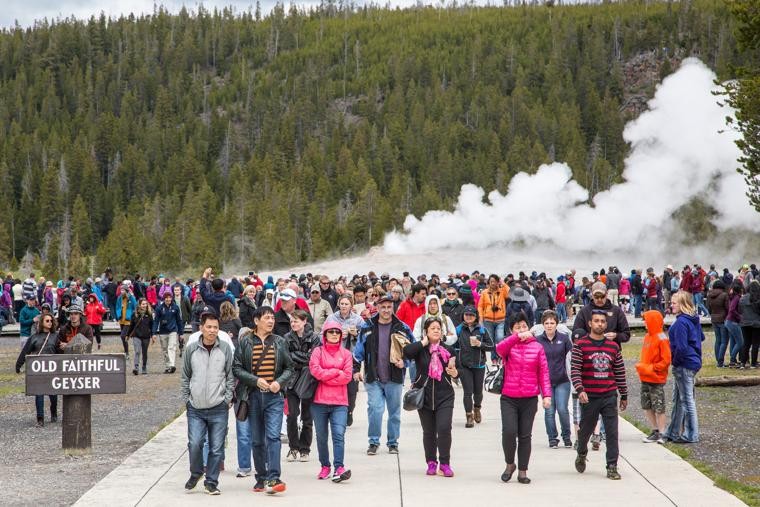Similar to a health check up, Yellowstone National Park recently took a look at its “Vital Signs.” And like a typical middle-aged American, some of the signs are OK and others are cause for concern.
The results of the study were included in a recently released report, “The State of Yellowstone Vital Signs and Select Park Resources 2017,” that summarizes a variety of key resources, ecosystem drivers, environmental quality and native and non-native animals within and around the park — a park inventory.
The report is a collaboration of several experts. The last such health check-up was done in 2013.
So doctor, give us the bad news first.
“There are concerns about diseases in the ecosystem like chronic wasting disease, the potential for white nose syndrome with bats and also aquatic invasive species and exotic plants moving in,” said Kristin Legg, who works for the park service as program manager of the Greater Yellowstone Network. “We’re getting a better idea of where we are with those and the potential for that to be a problem in the future.”
Legg said park staff can see where things are headed and make plans to prevent or reverse problems.
Legg used trumpeter swans and loons as an example. She said the birds are showing declines in “nesting success,” and park officials are closing areas where they know there are nesting loons and swans to help them “successfully get through their nesting period without human disturbance.”
“The park is taking action on a number of these different things,” she said.
Another area for concern is the mass of humanity — more than 4 million visitors each year — and its impact on the park.
“The park has social scientists on staff and they are doing a number of research and studies to look into what can they do in moving people around the park, what improvements can be made and should there be limits in the park,” Legg said. “They’re gathering information and exploring all options. Everything is on the table.”
Neal Herbert, park public relations officer, said studies include handing out iPads to visitors to track their movements in the park. Tablets are returned at the end of the visits and information is compiled.
“We’ve been doing this study one week a month from May through September,” Herbert said. “I’m sure it will take them a while to crunch their data.”
The park has seven different projects involving hired researchers, staff and volunteers to make observations and surveys concerning “visitor use management.”
“For example, a volunteer may sit in the parking lot at Mammoth Hot Springs for a period of time and record how many cars are usually in the lot, how many people come and go from that area,” Herbert said.
He said once the data is gathered and compiled from the projects, the park hopes to have an idea of specific challenges and possible solutions.
“It’s easy to make assumptions about what’s happening with visitation that don’t stand up with actual data collection,” he said.
Another negative on park health is climate change.
“There is a shift in snowpack and decreases in snowpack over time and the snowpack is shortening in season. It’s not around as long which affects stream flows and river flows,” Legg said. “We’re going to start seeing peaks in spring runoffs earlier because the snowpack is melting off earlier. We’re also going to see low flows earlier in the year. ... We’re also seeing wetlands drying as well. And how having wetlands more frequently drying affects not only amphibians but other species that rely on wetlands.”
But the Vital Signs report is not all bad news. Some animals have rebounded from poor numbers or situations.
“I think the grizzly bear work is a really great example of how working together collaboratively across multiple agencies and partners is a success story of how the population of grizzly bears has grown to the point of where it’s being delisted,” Legg said.
Another positive sign mentioned in the report and in recent news headlines is the restoration efforts of native cutthroat trout in Yellowstone Lake and elsewhere.
“Consistent, annual monitoring programs indicate an increase in the number of juvenile cutthroat trout since 2012. Angler success for cutthroat trout has also increased, and grizzly and black bears have returned to feed on spawning cutthroat trout in some tributary streams,” according to the report.
The report lists an example of improved water quality in the park with a reclamation effort on Soda Butte Creek in the northeast corner of the park. Tailings from a old mine site outside the park turned the water “an intense orange color” but after a collaborative cleanup effort, trout have returned to the stream and the greater Lamar River watershed.
Past Vital Signs reports did not mention cultural resources — things such as Old Faithful Lodge, historic buildings at Mammoth Hot Springs and museum collections.
“One of the cool things is that the park is entering into its collections museum objects for park use and researchers,” Legg said.
She said the park catalogs documents, plants, animals and even furnishings for park staff, researchers and families who have historical ties to the park to review. Many will go on display at the park’s museum.
“Even those yellow tour buses, that’s part of the museum collection. There’s one in a garage somewhere,” Legg said. “It’s an example of the type of things parks collect.”
Legg said that overall the Vital Signs report is a useful tool for scientists, staff and researchers.
“There is value in continuing this type of work, then pulling it together into one document so that we’re able to look at the big picture.” she said.
To read the complete “Vital Signs” report, go to www.nps.gov/yell/learn/management/vitalsigns.htm.



